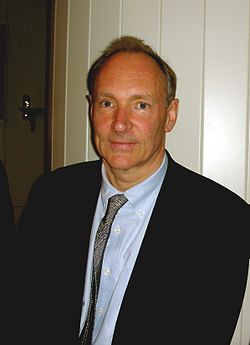Tim Berners-Lee
Sir Timothy Berners-Lee OM, KBE, FRS, FREng, FRSA (nick: timbl) (b. 1955) is an English-born scientist and software developer who created the World Wide Web in 1989 while working at CERN, and who subsequently started the W3C to promote open development on the Web. He currently is the Director of the W3C, the 3Com Founders Chair at the Computer Science and Artificial Intelligence Lab at the Massachusetts Institute of Technology in Cambridge, Massachusetts - and is involved with the Decentralized Information Group, which works on a variety of projects related to the Semantic Web. He is also the Chair of the Computer Science department at the University of Southampton in England.
Berners-Lee, a child of mathematicians, studied physics at Queen's College, Oxford, graduating in 1976. After this, he worked in the computer industry, at Plessey Controls Limited in Poole, England, and subsequently at D.G. Nash Limited, both working on software projects. After this, he worked as an independent consultant, which included a period at CERN, the particle physics laboratory in Switzerland. While at CERN, Berners-Lee created a hypertext database system called ENQUIRE for his own private use, which enabled him to better organise information. Until 1984, Berners-Lee worked as a software developer at Image Computer Systems Ltd. He eventually returned to CERN, and worked on hypertext systems, eventually proposing in 1989 a system which became what we know as the World Wide Web.
The first web server - info.cern.ch - was setup in 1990, on a NeXTcube machine in Berners-Lee's CERN office. It ran a server named httpd, and a client application called WorldWideWeb. These were released to the public in 1991. The protocols which would run the Web - HTTP, URI and HTML were formalised over the next few years. Berners-Lee also setup the World Wide Web Consortium (W3C for short) to manage development of Web standards in a unified and open way.
In recent years, Berners-Lee has been focused on developing, promoting and implementing the Semantic Web, a set of standards and practices that will complement the existing Web of documents by making a Web of data available in an atomic, universally referenceable way, so that computers can process the meaning behind the data. This has been promoted through standards like RDF, OWL, SPARQL and GRDDL, as well as the Linked Open Data project. He authors Design Issues, a set of papers about the design of the Web[1]. Berners-Lee also recently launched the Web Science Research Initiative[2].
Berners-Lee supports the principle of One Web, and opposed the .mobi top-level domain. He is a strong supporter of net neutrality. Berners-Lee is also a Unitarian Universalist[3].
[edit] External links
[edit] References
- ↑ Design Issues by Tim Berners-Lee
- ↑ Web Science Research Initiative, which is trying to promote scientific and academic research into the nature of the Web as a complex system
- ↑ The World Wide Web and the "Web of Life"


